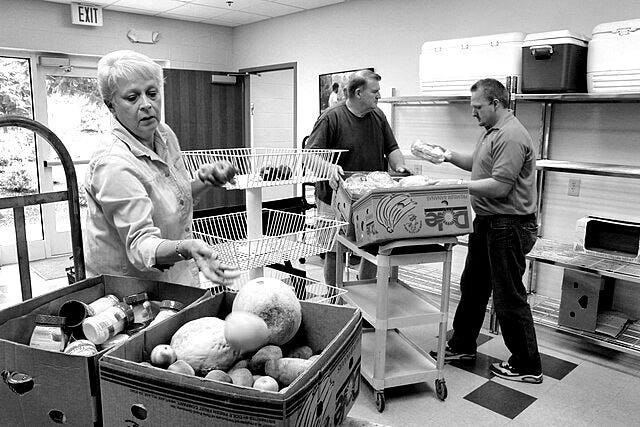When Having a Roof Over Your Head is Considered a Luxury
Many sacrificing buying food to afford rent, says spokesperson for Moisson Montréal.
This is the fourth article in a five-part series. Read the other articles here, on our substack.
We made everything free on our substack— if you want to support independant journalism this good, open, unpretentious, and willing to hold power accountable, consider supporting us for $5 a month!
From coast to coast, the housing crisis is hitting hard. In large cities and small communities alike, the struggle to find affordable housing is upending thousands of lives. What was once a fundamental right is turning into a privilege.
According to the latest figures from the Canada Mortgage and Housing Corporation (CMHC), the average rent in Canada topped $2,100 in 2025, with year-over-year increases nearing 10 percent in several urban centres.
In Toronto, Montréal and Vancouver, lines to view an apartment stretch ever longer, and applicants must present increasingly competitive files—sometimes even offering more than the asking rent, a practice never seen before.
Low-income households, seniors, recent immigrants and young adults are among the hardest hit.
A Hostile Street
In Montréal, emergency shelters such as Resilience Montréal are operating at full capacity—and at the mercy of the surrounding neighbourhood.
“What’s hardest isn’t finding money. It isn’t finding a building. It’s dealing with homeowners next door. Every day, we expect to be sued by our neighbours and forced to move,” said David Chapman, executive director and founder of the organization, which has a deep focus on serving Indigenous people experiencing homelessness. Resilience is in downtown Montréal, on the edge of Westmount near Cabot Square, a gathering place for many Indigenous people.
“The biggest obstacle we face at Resilience is our neighbours, who have plenty of resources yet want nothing to do with us,” Chapman said.
In Vancouver, tent encampments are sprouting in city parks, sometimes even on the grounds of hospitals or schools. Whenever initiatives arise—such as woodworker Khaleel Seivwright’s tiny shelters built for people experiencing homelessness in Toronto during the winter of 2020—are torn down by municipalities, often under pressure from well-to-do residents, merely shifting the problem elsewhere.
Choosing Between Housing and Food
The surge in housing costs is driving more and more people into poverty.
“Our food-bank clientele is diversifying. It’s no longer only people who are unhoused or on social assistance; we also see workers, students and newcomers,” said Éliane Larouche, communications lead at Moisson Montréal.
She said that after paying rent and clothing costs, food becomes the expense people cut.
Moisson Montréal’s latest “Hunger Report” notes that food banks have filled nearly one million requests each month—an increase of 10 percent since 2023. The rising cost of living, including high inflation and soaring rents, is the main driver of these requests.
“Over the past two years, some organizations have had to close waiting lists or shrink food baskets because they can’t meet demand. We had never seen that before,” Larouche said. “Geographically, the Montréal neighbourhoods hardest hit by food insecurity include Ville-Émard, Notre-Dame-de-Grâce, Côte-des-Neiges, Saint-Michel, Parc-Extension, the Sud-Ouest, Mercier and Hochelaga-Maisonneuve. Gentrification may be contributing to rising needs in areas such as Notre-Dame-de-Grâce.” Expanding the supply of affordable housing is one of Moisson Montréal’s key recommendations.
A survey by Habitat for Humanity Canada found that 59 percent of Canadians—75 percent of renters—now sacrifice other necessities such as food, clothing, basic household goods and education in order to pay rent or a mortgage.
Two-thirds of renters say their rent affects their mental health and well-being, and one-third of homeowners say the same of their mortgage.
A False Sense of Panic
“Tenants know they have rights, but the system is so unbalanced that fighting isn’t even worth it,” said Lynn O’Donnell, an advocate at the Verdun Citizens’ Action Committee.
She condemned landlords’ unfair tactics. “We see more and more disguised evictions and harassment: holes drilled in roofs, fake evacuation notices, heating systems removed,” she said, describing what she encounters almost daily.
“One landlord pretended the city was going to evacuate a building for soil contamination—even though the city knew nothing about it,” she said. “People need to stop signing anything under pressure. Landlords create a false sense of urgency. There is never an emergency to sign anything. Tenants are afraid to request repairs because they fear eviction or rent hikes. I’ve seen tenants wash at their kitchen sink for six months because they didn’t dare ask for repairs.”
She is not confident in governing bodies such as the Administrative Housing Tribunal (TAL), Quebec’s government arm meant to rule in conflicts between landlords and renters, as well ass determining annual rental hikes.
“The TAL is an eviction machine. It’s built for landlords. You can be in the right as a tenant and still wait forever to see a judge. And even when a landlord breaks the law, there are no criminal penalties,” she said.
In an email, a TAL representative said the tribunal is “neutral and impartial in carrying out its mission.”
“The mission of the Administrative Housing Tribunal is to resolve the disputes it is asked to hear and to inform citizens about the rights and responsibilities arising from a residential lease. Issues related to the housing crisis therefore fall outside our mission,” the statement said.
This investigation was made possible by a Québec Independent Journalists Association (AJIQ) excellence grant.




